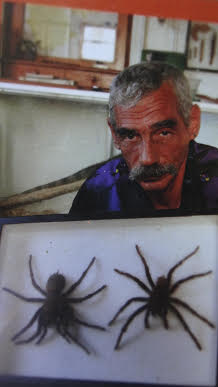Theraphosa Apophysis on:
[Wikipedia]
[Google]
[Amazon]
 ''Theraphosa apophysis'' is a
''Theraphosa apophysis'' is a
 ''Theraphosa apophysis'' is a
''Theraphosa apophysis'' is a species
In biology, a species is the basic unit of classification and a taxonomic rank of an organism, as well as a unit of biodiversity. A species is often defined as the largest group of organisms in which any two individuals of the appropriate s ...
of spider
Spiders ( order Araneae) are air-breathing arthropods that have eight legs, chelicerae with fangs generally able to inject venom, and spinnerets that extrude silk. They are the largest order of arachnids and rank seventh in total species ...
in the family Theraphosidae
Tarantulas comprise a group of large and often hairy spiders of the family Theraphosidae. , 1,040 species have been identified, with 156 genera. The term "tarantula" is usually used to describe members of the family Theraphosidae, although m ...
, found in Venezuela
Venezuela (; ), officially the Bolivarian Republic of Venezuela ( es, link=no, República Bolivariana de Venezuela), is a country on the northern coast of South America, consisting of a continental landmass and many islands and islets in th ...
and Brazil
Brazil ( pt, Brasil; ), officially the Federative Republic of Brazil (Portuguese: ), is the largest country in both South America and Latin America. At and with over 217 million people, Brazil is the world's fifth-largest country by area ...
.
Description
''Theraphosa apophysis'' generally resembles ''Theraphosa blondi
The Goliath birdeater (''Theraphosa blondi'') belongs to the tarantula family Theraphosidae. Found in northern South America, it is the largest spider in the world by mass () and body length (up to ), and second to the giant huntsman spider by ...
'', and reaches a similar size. Young ''T. apophysis'' spiders have pink shading at the end of each leg, which fades with each moult. ''T. apophysis'' has an additional stridulating
Stridulation is the act of producing sound by rubbing together certain body parts. This behavior is mostly associated with insects, but other animals are known to do this as well, such as a number of species of fish, snakes and spiders. The mech ...
organ on the coxa of the second leg and thinner femora than ''T. blondi''. The male ''T. apophysis'' has tibial apophyses (projections) – hence the species name. The ground colour of both sexes is coffee brown; the legs and opisthosoma
The opisthosoma is the posterior part of the body in some arthropods, behind the prosoma (cephalothorax). It is a distinctive feature of the subphylum Chelicerata (arachnids, horseshoe crabs and others). Although it is similar in most respects to a ...
have long scattered orange-brown hairs, with long orange hair on the femora. Mature males have a metallic sheen, described as "wine red" in colour, on the cephalothorax
The cephalothorax, also called prosoma in some groups, is a tagma of various arthropods, comprising the head and the thorax fused together, as distinct from the abdomen behind. (The terms ''prosoma'' and ''opisthosoma'' are equivalent to ''cepha ...
, the dorsal surface of the chelicerae
The chelicerae () are the mouthparts of the subphylum Chelicerata, an arthropod group that includes arachnids, horseshoe crabs, and sea spiders. Commonly referred to as "jaws", chelicerae may be shaped as either articulated fangs, or similarly ...
, the pedipalp
Pedipalps (commonly shortened to palps or palpi) are the second pair of appendages of chelicerates – a group of arthropods including spiders, scorpions, horseshoe crabs, and sea spiders. The pedipalps are lateral to the chelicerae ("jaws") and ...
s, and the coxa, trochanter and femur of the legs, as well as the patella of the first leg.
The female specimen on which the species was described had a total body length of , with the longest leg (the fourth) being long. The male had a somewhat smaller body, with a total length of , and slightly longer legs, the fourth being just under long.
Taxonomy
The species was first described by Andreas Tinter in 1991, as ''Pseudotheraphosa apophysis''. Tinter purchased an individual under the name "''Pamphobeteus exsul''", but realized that it could not be correctly named, as it possessed stridulatory organs. After further investigation, he named it as a new species in a new genus, ''Pseudotheraphosa''. In 2001, based on aphylogenetic analysis
In biology, phylogenetics (; from Greek φυλή/ φῦλον [] "tribe, clan, race", and wikt:γενετικός, γενετικός [] "origin, source, birth") is the study of the evolutionary history and relationships among or within groups o ...
, Rogério Bertani Rogério Bertani is a Brazilian arachnologist, active at the Butantan Institute.
He is credited as one of the foremost specialists in Theraphosidae
Tarantulas comprise a group of large and often hairy spiders of the family Theraphosidae. , ...
rejected this genus and placed the species in ''Theraphosa'', a view followed since by other workers.
In captivity
''Theraphosa apophysis'' is considered to be a difficult tarantula to care for and maintain, and is therefore not recommended for beginners. This is due to their nervous and defensive disposition, as well as high humidity requirements. However, their large size, food-aggressiveness, and fast growth rate makes then desirable for more experienced keepers.References
{{Authority control Spiders of South America Theraphosidae Spiders described in 1991